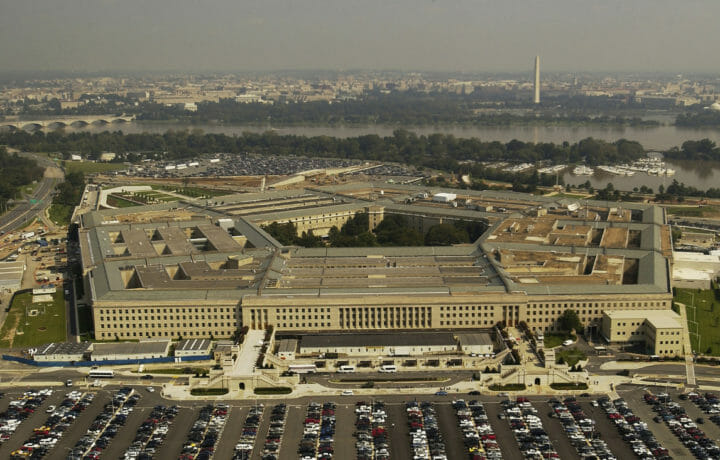Deputy Secretary of Defense Dr. Kathleen H. Hicks; Mr. Andrew Hunter, Performing the Duties of Undersecretary of Defense for Acquisition and Sustainment; and other senior Department of Defense leaders held a classified meeting with the Chief Executive Officers of the department’s eight largest prime contractors. The team met at the Pentagon to discuss ongoing security assistance to Ukraine and long-term readiness of U.S., Allied and partner forces.
Contractors with a seat at the table included: Boeing Defense, Space & Security; L3Harris Technologies; Raytheon Technologies; BAE Systems; Lockheed Martin Corporation; Huntington Ingalls Industries; General Dynamics; and Northrop Grumman.
Deputy Secretary Hicks highlighted the work already accomplished with fulfilling Ukraine’s priority security assistance requests, drawing down weapons from U.S. stocks when they are available, purchasing directly from industry for rapid delivery to Ukraine, and facilitating the transfer of weapons from Allies and partners when their systems better suit Ukraine’s needs.
The deputy secretary emphasized how Russia’s invasion has highlighted the importance of frequent, direct dialogue with industry to ensure we are prepared to support three strategic objectives:
- Delivering critical capabilities to Ukraine;
- Enhancing the preparedness of our own forces; and
- Supporting our Allies and partners in bolstering their defense capabilities.
The dialogue focused on accelerating the production and fielding of systems that are critical to the Department’s ongoing security assistance to Ukraine, as well as broader efforts to increase the readiness of U.S., Ally, and partner forces. Department leaders sought to understand what challenges large companies in the defense industrial base faced in accelerating fielding of critical capabilities, and how the Department might be able to alleviate these issues.
Following the deputy’s remarks, Mr. Hunter and other senior acquisition, sustainment and policy leaders moderated the roundtable portion, which focused primarily on accelerating production and building more capacity across the industrial base for weapons and equipment that can be exported rapidly, deployed with minimal training, and prove effective in the battlefield. Further discussion covered capabilities within various portfolios, including: air defense, anti-armor, anti-personnel, coastal defense, counter-battery, and communications.
Both Secretary of Defense Lloyd Austin III and Deputy Secretary of Defense Dr. Kathleen Hicks continue to engage with more than 200 industry leaders as a part of a persistent, open communication strategy to advance the DoD’s understanding of industry priorities and challenges.
Layoffs Impacting the Cleared Industry
| Better.com |
Sometimes, it just feels like you can’t possibly write this script -even if you tried. But Better.com is headed into a third round of layoffs. Of course, mass layoffs probably won’t happen this time over Zoom, but it’s still not an encouraging sign for the faithful that have remained after the first viral layoff. If company officials were hoping to lay low and quietly restructure without the world noticing that they were shedding hundreds of employees at a time, they have not been given that privacy. But what they are providing for human resources everywhere is a playbook on how to deal with restructuring an organization – even if it gives painful examples of what not to do. |
|---|
Hiring impacting the Cleared Industry
|
Lockheed Martin |
If you like a little more heat in your life, head to Florida for a job with Lockheed Martin. The contractor has plans to add hundreds more jobs in the region, supporting its work on the F-35. |
|---|
Cleared Employer at Work: CISA
Women have a small representation in cybersecurity, and yet they remain critical to the mission – CISA knows this and is looking to bring in people with the unique backgrounds and perspectives that represent our Nation. CISA has career pathways for people of all backgrounds, with the goal of creating a more balanced and inclusive workplace culture. Join the CISA workforce!
Opportunity to Watch
NASA is expanding at their Langley Research Center, building on a proud legacy of innovation and technical excellence, discovering solutions that shape a better world for all. Langley’s new Measurement Systems Laboratory, or MSL, is a powerful new resource that accelerates their efforts and deepens their impact. The building officially opens Thursday, May 21, with a ribbon cutting ceremony and celebration.
Prior to the ceremony, media will tour the 175,000 square foot facility and view cutting edge labs and other features.
The ceremony itself will feature remarks from General Services Administration’s Acting Regional Director for the Mid-Atlantic region, Joanna Rosato, Langley Center Director Clayton Turner, Del. Jeion Ward of Virginia’s 92nd house district, and a pre-recorded message from Sen. Tim Kaine.
Information about the Measurement Systems Laboratory:
- Work at the Measurement Systems Laboratory will accelerate a host of Langley projects in aeronautics, space exploration and Earth science.
- Sensor and antenna technologies developed at the MSL will be vital to advances needed to make revolutionary ideas like personal air vehicles and Advanced Air Mobility — possible.
- Experiments with laser testing technologies in the MSL will help NASA improve Computational Fluid Dynamics (CFD) computer models of aerodynamic flow and heating which will, in turn, speed the development of new, more capable air and space vehicles.
- New sensors developed at the MSL will help to improve the safety and efficiency of commercial aviation.
- Refining lidar sensing techniques and technologies will benefit Entry, Descent and Landing concepts for Moon and Mars exploration. The MSL will assist in creating instruments that can draw 3D maps of surface terrain, helping spacecraft navigate to a safe landing on remote worlds.
- By improving lidar sensing techniques, Langley researchers in the MSL will help create instruments that will make new, expansive measurements of wind, clouds, dust, and smoke. This will expand understanding of Earth’s atmosphere, weather, and climate.
- Sensors and instruments developed for continuous space observation of Earth’s air quality will help scientists monitor pollution on a regional and global scale.
- Advanced sensors and instruments developed in the MSL will help NASA create spacecraft and habitats that sense and respond to the dynamic space environment — keeping astronauts safe on long missions.



